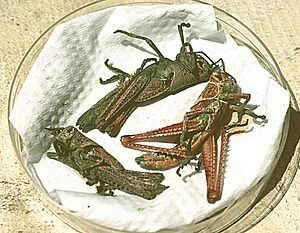Red locust facts for kids
Quick facts for kids Red locust |
|
|---|---|
 |
|
| Scientific classification | |
| Genus: |
Nomadacris
|
| Species: |
septemfasciata
|
The red locust (Nomadacris septemfasciata) is a very large type of grasshopper found in sub-Saharan Africa. It gets its name from the reddish color of its back wings. In French, it's sometimes called criquet nomade, which means "nomadic grasshopper," because it moves around a lot during the dry season. When many red locusts gather together and fly in huge groups, they are called a locust swarm.
Red locusts belong to the family Acrididae. They are the only species in their group, called the genus Nomadacris. This group was named in 1923 by Boris Uvarov. The red locust itself was first named Acridium septemfasciatum by Jean Guillaume Audinet-Serville in 1838.
Contents
What Red Locusts Look Like
Adult Red Locusts
Adult red locusts are usually a mix of light beige and brown. They have seven brown stripes across their front wings, which are called elytra. This is why their scientific name includes septemfasciata, meaning "seven-banded." They also have two brown stripes on the sides of their pronotum, which is the shield-like part behind their head.
Male red locusts are about 60 to 70 millimeters (2.4 to 2.8 inches) long. Females are a bit larger, measuring 60 to 85 millimeters (2.4 to 3.3 inches) long.
Young Red Locusts (Nymphs)
Young red locusts, called nymphs, look different from adults. Their color changes depending on how many other locusts are around.
- When they are alone, nymphs can be green or brown. This helps them blend in with their surroundings.
- When they are in large groups, nymphs become bright yellow and red-brown with black marks. This bright coloring might warn predators that they are part of a big group.
How Red Locusts Live
Red locusts like to live in wet places, such as areas that flood during certain seasons. They mostly eat grains, so grassy lowlands are perfect homes for them. They also enjoy spending time in trees, so they prefer places with some tree cover.
When there is enough food and shelter, red locusts tend to stay in one place. However, in dry years, there is less suitable habitat. This causes more locusts to gather in the same small areas. When too many locusts are in one place, they change. This is called their gregarious phase.
Swarming Behavior
When red locusts enter their gregarious phase, their behavior and even their bodies change.
- They gather into huge swarms and fly with the wind during the day. They are looking for more food.
- Warmer temperatures during the day help them fly longer and higher. They use "thermal lift," which is like riding warm air currents.
- A swarm usually travels about 20 to 30 kilometers (12 to 19 miles) in a single day.
- In contrast, locusts that are alone prefer to fly at night.
Compared to when they are alone, gregarious red locusts also have:
- A shorter life.
- More markings on their bodies.
- Six growth stages (called instars) instead of seven.
- A longer time before they are ready to reproduce.
- Larger and heavier young, even though the females lay fewer eggs.
Female locusts in a swarm often lay their eggs at night. Their young immediately behave like a swarm and can "hop" hundreds of meters each day.
Red Locust Outbreaks
Areas where red locust outbreaks often happen include Zambia, Tanzania, Malawi, Madagascar, and Réunion. In the Sahel region of Africa, they are seen less often. They have been spotted in Cape Verde, the central Niger River delta in Mali, and around Lake Chad. The last very large outbreak happened from 1930 to 1944, when almost all of southern Africa was affected.
For a long time, people tried to control red locusts by changing their environment. Now, chemicals are often used. There is also a natural product available that uses a special entomopathogenic fungus called Metarhizium acridum. This fungus can make locusts sick and kill them. It has been successfully tested on both young and adult red locusts.
More recently, a new way to control pests has been developed called Integrated Pest Management (IPM). This method combines several environmentally friendly ways to manage pests effectively. For example, studies have looked at how birds like the Cattle Egret can help control locust populations.
See also
 In Spanish: Nomadacris septemfasciata para niños
In Spanish: Nomadacris septemfasciata para niños




